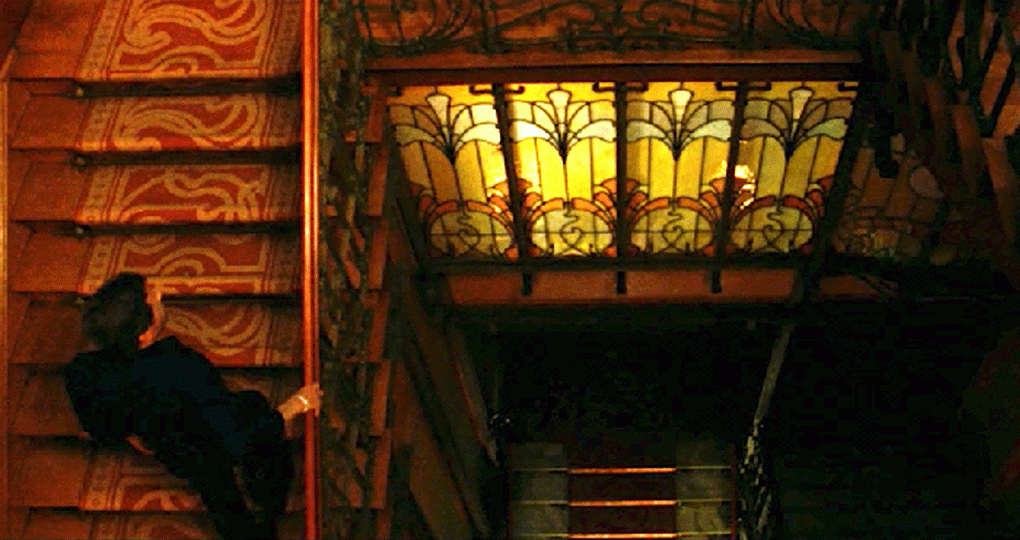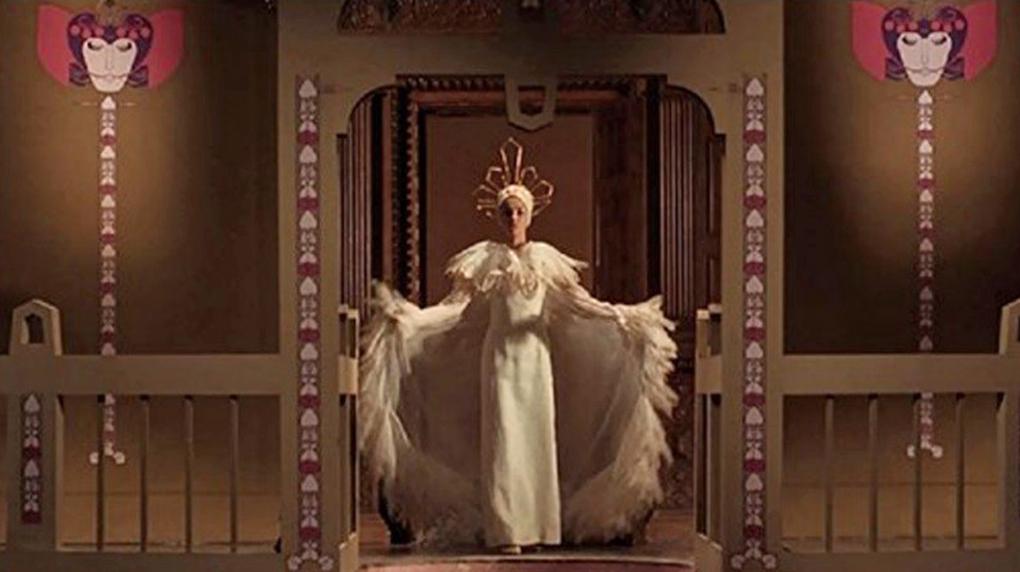
Choices concerning a film’s production design are made for numerous reasons. Most obvious is authenticity, by which the look of sets and props conforms to the era and culture in which the drama takes place. In movies of the 1930s, set amongst the wealthy leisured classes, for instance, production design was often marked by an Art Deco sensibility, one associated with modern chic and luxury. Alternately, decisions concerning art direction can be made on a largely aesthetic level in an attempt to create arresting screen beauty. This might be said of films like Wes Anderson’s The Grand Budapest Hotel (2014) or Zhang Yimou’s Curse of the Golden Flower (2006). Often, however, determinations of production design are made for symbolic or thematic reasons linked to the film’s narrative. In Michelangelo Antonioni’s Red Desert (1964), for instance, a sense of the aridity and toxicity of the industrial world is created through a color palette that ranges from putrid yellows, browns and greens to icy antiseptic whites and blues. In most instances, production design can be attributed to a mixture of all three rationales.
In the case of the horror film, art direction must primarily invoke generic motifs of perversity and terror. This is true of certain contemporary works that employ an Art Nouveau aesthetic to achieve this effect. In utilizing the design school to signify monstrosity, these films mimic earlier critical conceptions of the movement that regarded it as grotesque, dreadful, and unsettling.
In pursuing links between Art Nouveau and cinema, I am one of only a few scholars to note such connections. In fact, if one searches the indices and Tables of Content of countless volumes on cinema, one finds but a scant mention of the term. There are many reasons for this omission1. First, Art Nouveau’s popularity was short lived, from the late 19th century to the beginning of the First World War. Second, by the time, films became refined enough to employ sophisticated mise-en-scene, the heyday of Art Nouveau had passed. Third, Film Studies has not generally paid much heed to the links between cinema and other art forms than literature and theater (favoring instead its connections to politics, social history, and popular culture).
Art Nouveau
In order to appreciate Art Nouveau’s influence on horror film production design, it is necessary to provide some background. Art Nouveau, was primarily a trend in the applied arts. While the term derives from its French incarnation (and was associated with the 1900 Paris Exposition Universelle where it debuted), the movement also had branches in Germany, Austria, England, Belgium Scotland, Spain, Italy, and Russia. Given Art Nouveau’s intent to create new forms indicative of the age, it left its imprint on such diverse crafts as: architecture, interior decoration, glassware, pottery, statuary, illustration, fabric patterning, jewelry, metal work, wood carving, set design, and painting – its goal being a Wagnerian Total Art.
Art Nouveau had certain favored tropes and subjects. As for the first, it was known for the so-called “whiplash curve” – a sinuous, wavy line that opposed the geometric right angle. As for the second, it was fixated on Nature – seen as an antidote to the new, soulless, industrial world. Here one notes Art Nouveau’s ubiquitous floral and animal imagery as seen in countless glass pieces by Émile Gallé. The movement was also obsessed with the image of Woman – as displayed in the work of Alphonse Mucha. With a focus on the female, came intimations of the Erotic, this, in a period still ruled by Victorian morality. Finally, Art Nouveau borrowed modalities from the Orient (primarily Japan and North Africa). The former can be seen, for instance, in Eugène Rousseau’s “Carp Vase” (1878-84), and the latter in the movement’s architectural use of the Islamic arabesque (as in buildings by Antoni Gaudí).
When Art Nouveau was first promoted as a design style, many of the era saw its iconography as profoundly troubling. For some, the whiplash curve was a dizzying, vertiginous form and a refusal of the staid straight line. For others, its intricate, undulating curves communicated a sense of entrapment. As for the movement’s natural imagery, though Art Nouveau often depicted harmless and lovely creatures (like the butterfly or peacock), it also portrayed disconcerting ones – like the bat or snake. And while its vision of Woman was frequently Romantic (as in glass pieces by René Lalique), it could also be disquieting, as in Gustav Klimt’s painting “Pallas Athene” (1898). Furthermore, Art Nouveau’s rampant Orientalism tethered it to the ethnic Other – seen as primitive and inferior in an age of Western Imperialism. Finally, Art Nouveau was not only sensually suggestive, it was often viewed as salacious and risqué, as in the graphic work of Aubrey Beardsley, with its strange androgyny and sadistic sexuality.
For this reason, if one peruses newspapers of the period (for instance, The New York Times) one finds the following pejorative adjectives associated with works of Art Nouveau: weird, corrupt, unhealthy, meaningless, fantastical, injurious, inharmonious, and even criminal. Several other negative epithets are hurled at the movement by a writer in 1915 who regrets: “the pernicious and monstrous developments, or rather perversions, which the misguided schools of painting and sculpture have undergone in recent years.”2
But there is another charge that was hurled at Art Nouveau in the era of its ascendancy that brings us closer to the film genre I will consider. A writer in the New York Times of November 20, 1904 complained about its “horrid forms,”3 while another of July 17, 1927 referred to its “horrors of bad taste.”4 A more extensive meditation on the theme was articulated by a writer in the Times of January 1907 in an article about modernist bookbinding. The author speaks of a designer who “has followed the spirit of l’art nouveau, and has created an ignis fatuus (in other words, a horror show). He continues: “[I]n his search for the new [the designer] has found the grotesque. Serpents crawl over human skulls and wriggle in and out of his border lines or with protruding tongues stare out at us from behind foliage or through a crevice in some of his designs.”5
It is no accident that these writers make reference to horror in describing what they view as an abhorrent design movement – a term that signifies fear, disgust, and fright. Furthermore, some decades later, Walter Benjamin invoked a similar word, phantasmagoria, to describe what he deemed to be the unsavory Art Nouveau interior – thus referencing a type of 19th century magic lantern show that projected eerie images of ghosts, specters, and zombies6.
Given all this, it should be no surprise that we sometimes find Art Nouveau linked iconographically to the horror genre – be it on stage or on screen. In fact, in Paris, in the same era in which Art Nouveau surfaced, there was a dramatic form of that type, the Grand Guignol, performed at a theater that bore its name. A description of the genre by historian Mel Gordon in fact, might serve as one for Art Nouveau: “A product of fin-de-siècle France, the Grand Guignol managed to outrage its public as it explored the back alleys of unfettered desire, aesthetic impropriety, and nascent psychological trends.”(Gordon 1988: 2)
The Grand Guignol Theater was opened by Oscar Méténier in 1897 – only two years after the birth of cinema – so they were contemporary forms. Plays produced there focused on “slice of death” plot lines: “Every social taboo of good taste was cracked and shattered. This formula would attract the French public that slaked its blood and lust fascination with the morbid devouring of pulp novels and unlikely tabloid exposés.”(Ibid.,19) The Grand Guignol’s audience was quite diverse and included members of the Parisian avant-garde – so we can imagine some of the practitioners of Art Nouveau attending.( Ibid.,18) Significantly, the theater was one of the venues used to project films at the 1900 Paris Exposition which introduced the world to Art Nouveau7.
Art Direction and Cinematic Horror
Certainly early cinema shared a lot with the Grand Guignol in its taste for sensationalism, violence, and melodrama. And a British poster from 1920 reveals that the Grand Guignol form soon migrated to the movie screen. Eventually, however, the cinematic Grand Guignol morphed into the horror film, a narrative mode that is still with us today.
The Abominable Dr. Phibes
My concern, however, is with certain contemporary works in which grisly scenarios take place in Art Nouveau settings – indicating that the style is still seen as “horrific.” One example is The Abominable Dr. Phibes (1971)8 directed by Robert Fuerst (with production design by Chris Burke and Brian Eatwell). Its choice of adjective to describe Dr. Phibes reminds us that, in 1904, the president of the Royal Institute of Architects deemed Art Nouveau an “abominable affectation.”9
The film stars Vincent Price (as Dr. Anton Phibes) in a drama, set in London of the 1920s which concerns a series of murders whose victims are all physicians. In attempting to tie the executions together, police learn that all the men were linked to an unsuccessful surgery on a woman named Victoria Regina Phibes, who died on the operating table. This leads them to suspect her husband, Dr. Anton Phibes of the crimes. But they learn that he is deceased – so the detectives are stumped.

The viewer, however, knows that Dr. Phibes is still “alive” – having been resurrected by some ghoulish, supernatural process. He is a famous organist (like The Phantom of the Opera) living in a modernist mansion with his assistant Vulnavia (Virginia North) who is often dressed in an antique style (associated with the era of Art Nouveau) (see figure 1). During that period Bohemian women often followed a trend known as “aesthetic fashion”:
In contrast to the fashion at the time, Aesthetic dress rejected any kind of restrictive corsetry. . . Usually made of . . . silks or velvet fabrics, such a dress was cut looser and was unstructured in the style of medieval or Renaissance garments with larger sleeves. The dress appeared loose compared with figure hugging fashion garments of the era10.
Dr. Phibes’ mansion is marked by touches of Art Nouveau. A background wall decoration (depicting the heads of women) is a modern take on Austrian Jugendstil design. Furthermore, the floor of the estate’s main hall is emblazoned with a curvilinear, decorative pattern rendered in the manner of Scottish designer Charles Rennie Macintosh (see figure 2). Furthermore, a phonograph horn, lamp, and sculpture in Dr. Phibes’ bed room are reminiscent of Art Nouveau pieces (see figure 3). Finally, a chandelier has the look of those crafted by Art Nouveau glass makers (see figure 4).
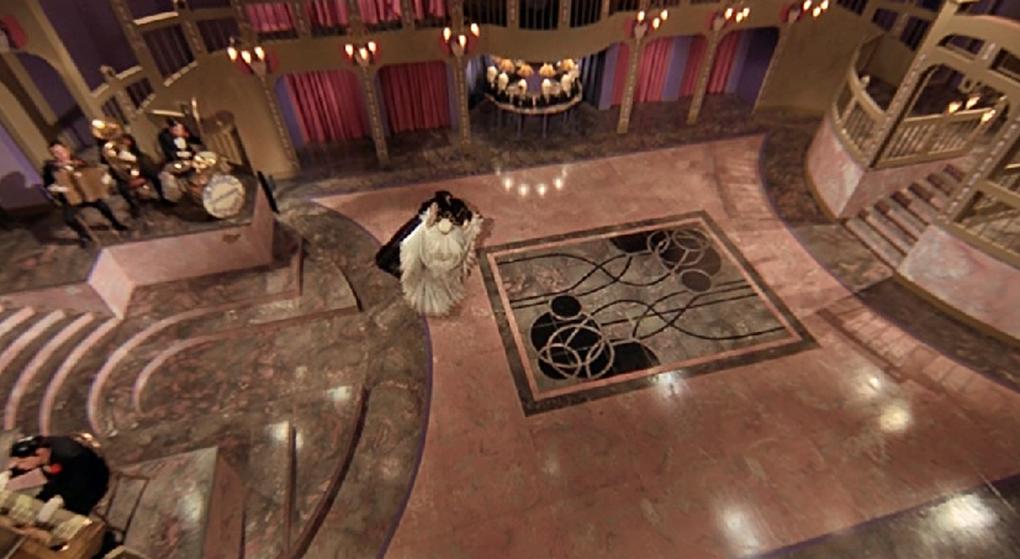

Significantly, the homes of Dr. Phibes physician-victims also bear traces of Art Nouveau design. Dr. Dunwoody’s house includes a mirrored Art Nouveau armoire and Tiffany-style lamps. He is killed when Phibes and Vulnavia unleash upon him some bats that savage his body. The police remark that another doctor was killed a week earlier in an equally bizarre fashion, when hundreds of bees stung him causing deadly boils.
We witness the third murder when Dr. Phibes attends a masquerade party and gives Dr. Hargreaves a gorgeous (but deadly) gilt frog mask (that resembles an Art Nouveau ring made by the Spanish jeweler Lluis Masriera) (see figure 5). The fourth homicide occurs in the home of Dr. Longstreet, one that is also marked by Art Nouveau touches – for instance, its wall paper, a modernist painting, and a female bust on a credenza (redolent of the work of Spaniard Lambert Escaler Milà) (see figure 6). Longstreet is seen threading a film on his home projector and lasciviously watching a black-and-white, “blue” movie depicting an Arab belly dancer. We are familiar with this female Orientalist figure from many Art Nouveau works, for instance, Gustav Moreau’s “Salome Dancing Before Herod” (1876). Mesmerized by the woman, the doctor fails to hear Dr. Phibes enter his home, equipped with instruments to drain him of his blood. When the police arrive, they find that the murderer has dropped a pendant with a strange symbol on it – an important clue.
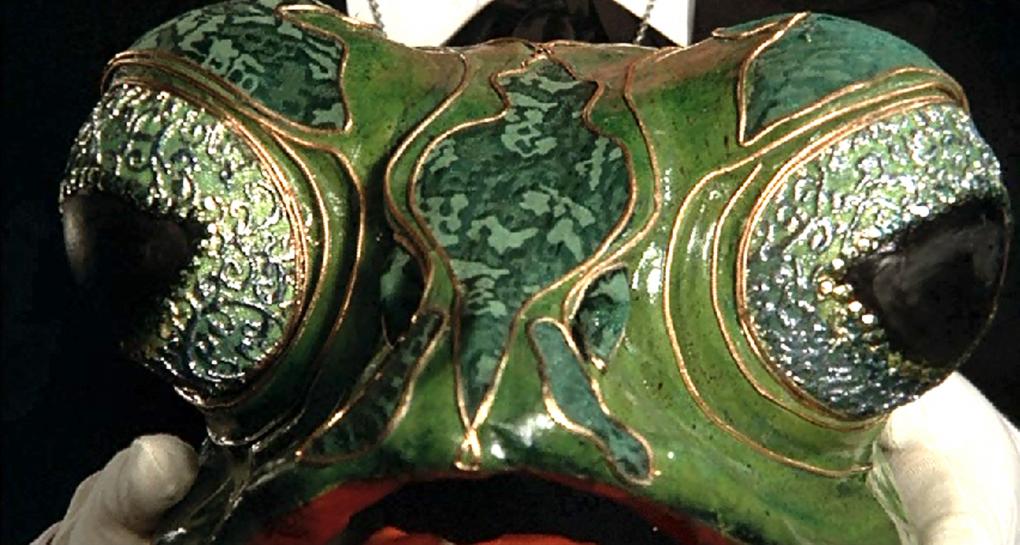
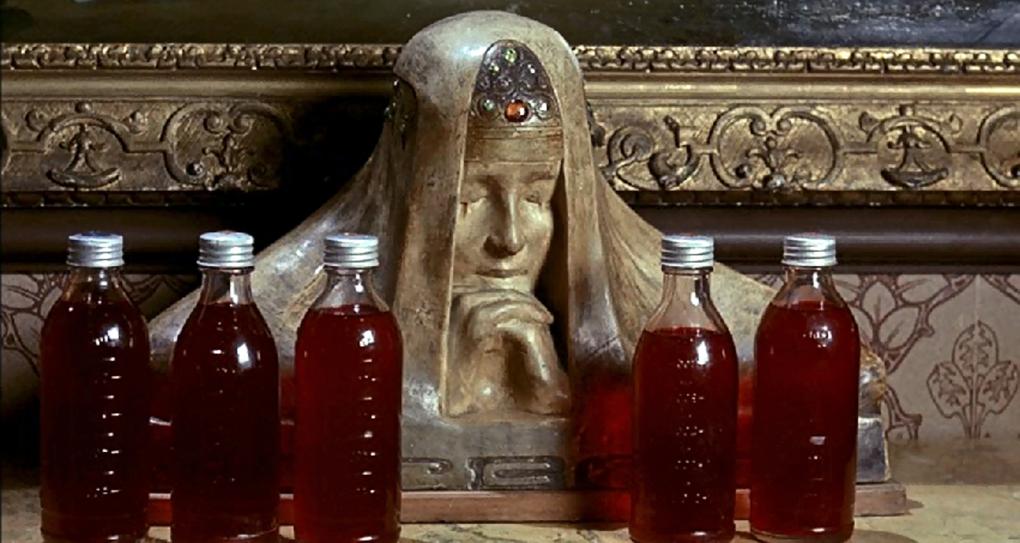
They take the pendant to the jeweler that crafted it and he reveals that it was part of a set of ten he made for Dr. Phibes – each with a different Hebrew letter on it. When the police consult a rabbi, they learn that the lost pendant bears the symbol for “blood” – one of the ten plagues that the Hebrew God visited upon the Egyptians during the Jews’ exodus from that land – the others being boils, bats, frogs, rats, hail, beasts, locusts, darkness, and death of the first born. In these “anathemas,” the police immediately recognize the causes of the strange deaths they are investigating, and we identify the kind of macabre animal figures sometimes associated with Art Nouveau (for instance, Louis Comfort Tiffany’s Bat Table Lamp [ca. 1905-6]).
Several other homicides occur in line with the Biblical plagues. Fearing for the life of a nurse who assisted on Victoria Phibes’ unsuccessful surgery, the cops sequester her in a room (covered with Art Nouveau wallpaper). But Dr. Phibes manages to drill down from the floor above and inject locusts into her chamber to devour her. Needless to say, the police eventually solve the case, realizing that Dr. Phibes is, preternaturally “alive” and avenging the death of his spouse. However, he escapes their clutches, and descends to his basement where he joins his wife in a casket.
There is much that can be said about this fascinating, visually striking movie – a cinematic Grand Guignol if ever there was one. It even includes a scene involving Phibes’ sadistic use of an operating table, a pioneering prop of Grand Guignol drama11. Significantly, we glimpse it through a glass pane in his Rennie Mackintosh-inspired floor.
Clearly, an Art Nouveau ambience attaches to the home of Dr. Phibes as well as those of some of his victims. Here, the design movement contributes to the horror film aura in its repurposing as a marker of decadence, cursedness, and death. The latter is apparent not only in the fate of the murdered physicians, but in Dr. Phibes’ vampire-like being.
Another link to Art Nouveau is Dr. Phibes’s association with creativity – since the movement was identified with “art for art’s sake.” Phibes was once a renowned organist who performed at such hallowed venues as the Palace and the Royal Albert Hall. Posters for his performances reveal that among the recitals he gave at the turn of the 20th century, was one of Salome – a veritable Art Nouveau icon. Furthermore, he is an artist in another ghastlier sense. He creates busts of all the people he intends to kill, and after he has murdered them, he takes an acetylene torch to their sculptural faces in order to melt them. Interestingly, the Art Nouveau style has often been seen, metaphorically, to dissolve or liquefy linear form.
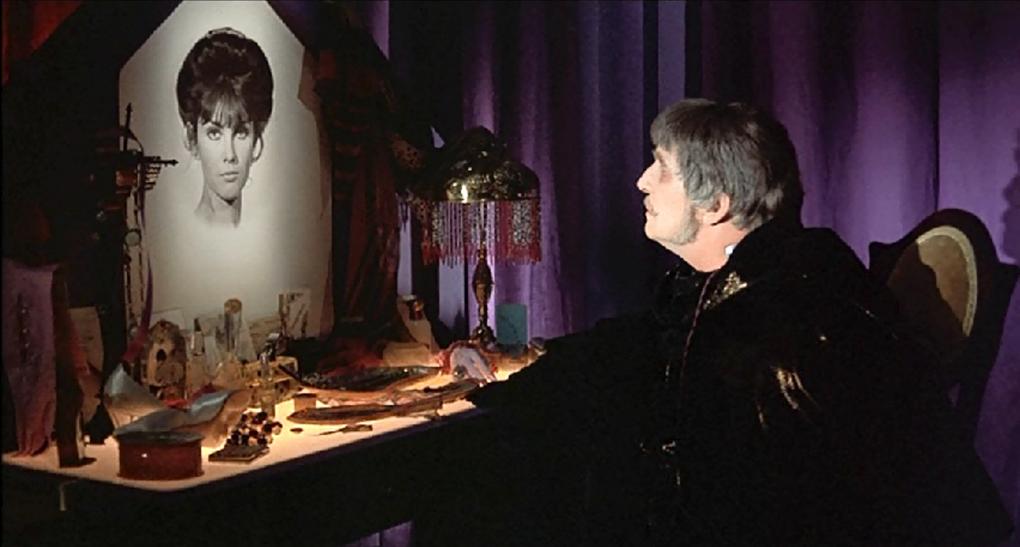
Dr. Phibes’s obsession with women also seems indicative of an Art Nouveau sensibility and is reflected in the film’s set design. Instead of a framed mirror placed in his vanity, there is a huge photograph of his deceased beloved (see figure 7). And at one point (in a Phantom-of the Opera-like posture), he plays the organ, above which are projected photographic slides of his dead spouse (see figure 8). Evincing a more hostile attitude to women, when he drills through the floor below which Nurse Allen sleeps, he lays down a large diagram of a naked woman and aims the bit through her face (see figure 9).
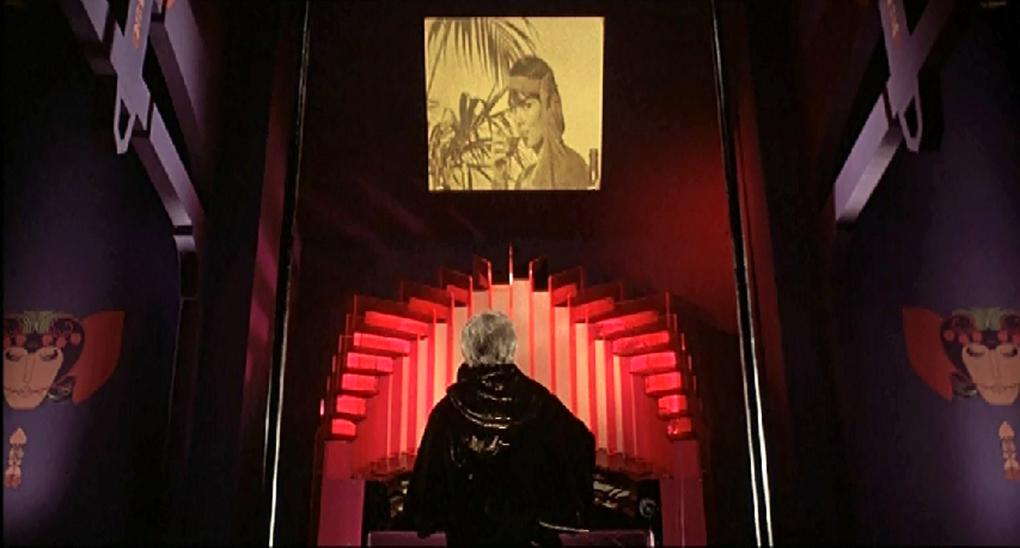
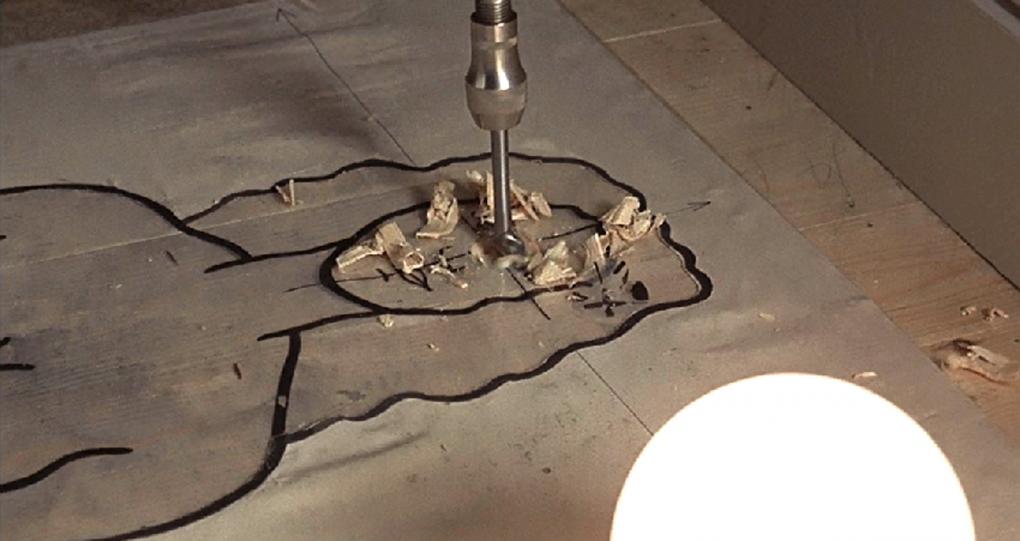
As noted earlier, Phibes’s assistant is also portrayed in an Art Nouveau manner. In one scene, she strikes a butterfly pose, and in another, appears in a spider gown – in both cases reminding us of those female/insect hybrids so ubiquitous in Art Nouveau jewelry (see figure 10). In a later scene, she wears a large gold necklace with curved and interlocking branch/snake-like projections – signifying a more ominous use of Art Nouveau’s natural imagery. Furthermore, her cap, with its ball tipped protuberances reminds us of peacock feathers, omnipresent adornments in the Art Nouveau era (see figure 11).
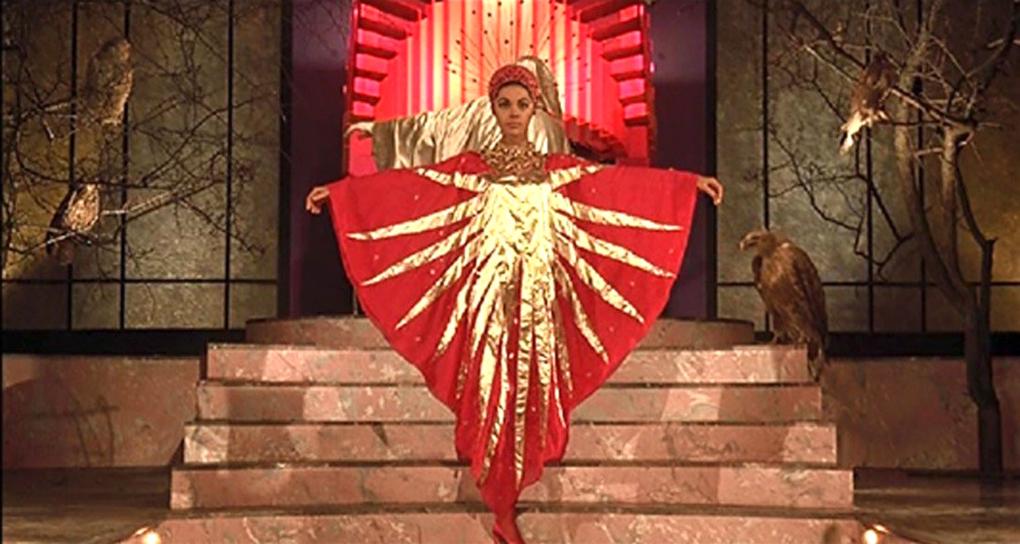
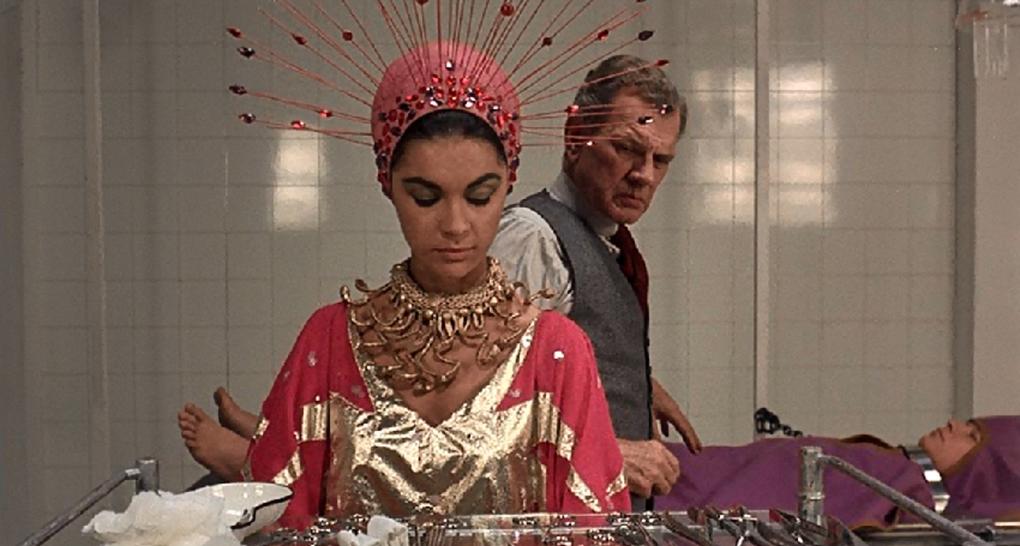
In the film narrative’s invocation of the plagues, we are reminded of the fact that a scholar once likened Art Nouveau to a “bacillus” spreading from place to place, and that Germans once deemed it the “Belgian tape-worm style.”(Bade 2011: 98) Significantly, both epithets invoke disease – another trope often linked to horror.
Deep Red
A second contemporary film whose production design associates Art Nouveau with death and terror is Deep Red (1975) directed by Dario Argento – a master of cinematic Grand Guignol (in its Italian giallomode). He is known especially for his use of lush, mise-en-scène as well as his emphasis on violence and spectacle12. Production design and set decoration for the film are attributed to Giuseppe Bassan and Armando Mannini, respectively.
Plot wise, the movie is a fairly standard genre piece, with psychoanalytic overtones in the manner of Alfred Hitchcock’s Psycho (1960). As the narrative begins, a well-known parapsychologist Helge Ullmann (Macha Méril) is mysteriously killed in her Rome apartment after giving a lecture at a conference on the paranormal where she sensed “something strange” going on in the hall and heard disturbing voices speaking cryptically about some mysterious “house.”
Later that day, musician Marcus Daly (David Hemmings), a resident of Ulmann’s building, observes her being murdered through a window while chatting in the square below the building with his friend Carlo (Gabriele Lavia). (Interestingly, as Ulmann collapses, we see her fall against a Tiffany-style lamp, an object associated with Art Nouveau). Daly decides to assist in attempting to solve the crime and, as the investigation proceeds (with police engaged as well), numerous other people are slaughtered in the same puzzling and bloody fashion.
In terms of production design, however, it is one location that deserves special attention. In Daly’s search for Ulmann’s assassin, he is reminded that, at the conference, she heard enigmatic voices speak of a strange house. Because of this, someone suggests that Daly research a book entitled The Modern Ghost and Black Legends of Today, available at the Library of Folklore and Popular Traditions. Daly goes there and accesses the volume. One chapter, in particular, sparks his interest: “The House of the Screaming Child,” about a sinister, uninhabited, mansion from which neighbors hear the eerie strains of a child’s song (which the audience has heard periodically on the soundtrack).
Daly manages to track down the house pictured in the book. He learns from a caretaker that the residence (known as the “Ghost House”) was once owned by a man who died falling out of one of its windows. It is now for sale, but rumor has it that it is inhabited by spirits. When Daly goes there he finds an abandoned, derelict, Art Nouveau estate – in Argento’s mind, the perfect scene for Gothic horror (see figure 12).

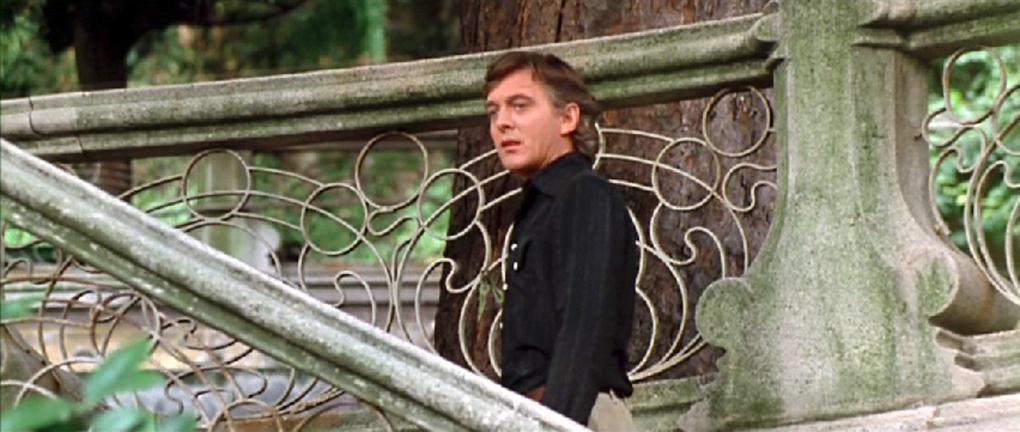
The house is surrounded by an ornate Art Nouveau gate through which Daly must pass. The exterior of the house is also marked by an Art Nouveau aesthetic: there are curvilinear intricate concrete moldings and windows with whiplash mullions (see figure 13). In approaching the house, he must climb a stairway embellished with an ornate metal balustrade (see figure 14). He enters through the front door, which is characterized by an Art Nouveau glass and wood design, an element echoed in the home’s many windows (see figures 15 and 16).
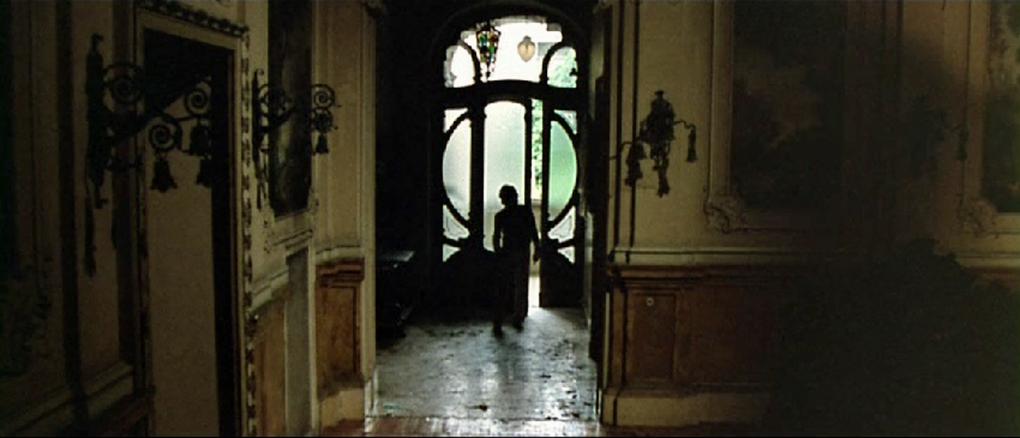
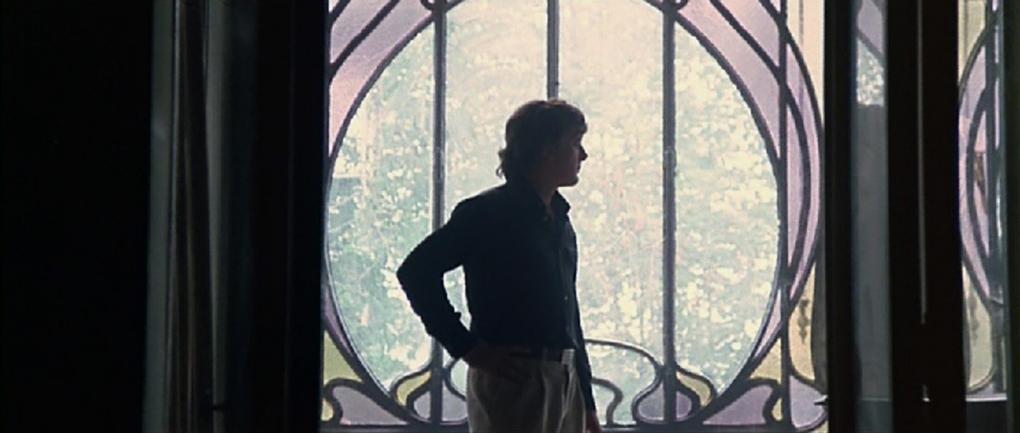
.As he wanders through the building’s endless halls and stairways, the camera continually tracks or pans along with him – mirroring the curves of the building with the movement of the apparatus. Daly becomes covered with dust, cobwebs, and plaster and discovers, on one wall, a splash of red coloring (as though the house were bleeding). Inquisitive, he chips away at the spot with a shard of glass and uncovers a childlike drawing that depicts a wounded man and a boy wielding a knife. In unearthing the picture, Daly cuts himself and bleeds – linking his body with the house and the gory scene depicted on its wall.
Daly later returns to the mansion on his own and breaks in. Once inside, he walks down a corridor and notices a rectangular marking on the wall where a picture once hung. With his chisel, he hacks away at the spot, making a hole large enough for him to see a hidden room within which there is a petrified corpse – mouth agape in a scream-like grimace (see figure 17).
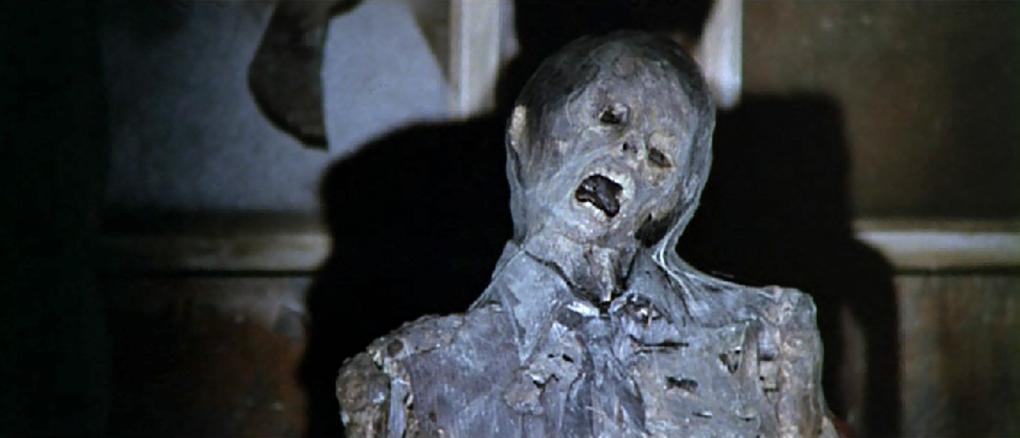
When, later on, Daly speaks to the manor’s groundskeeper, he notices a picture on the man’s refrigerator that resembles the one he found on the mansion wall. He learns that the groundskeeper’s daughter drew it. When questioned, the girl says that she copied it from one in the archives of her school. Daly ventures there (passing through another Art Nouveau gate) and breaks into its archives, where, under the label “Design,” he finds files of student art and eventually the very drawing he seeks, which turns out to have been made by Daly’s friend Carlo when he was a child.
As subsequent scenes reveal, however, it is not Carlo who is the serial killer, but his mother – who traumatized Carlo as a youngster by murdering his father before his eyes. (The drawing represents the moment when Carlo extricated the knife from his dad’s body). Hence, Daly’s having to excavate the walls of the Art Nouveau mansion to find clues to the murders – bears comparison to a psychiatrist needing to mine someone’s unconscious to find keys to his psyche. Here, we also have a tie between Art Nouveau and madness – a fitting link for a movement that came of age with psychoanalysis. Significantly, when French architect Hector Guimard (who designed the famous Paris Metro entrances) erected a house in Paris called the Castel Béranger, the public called it the Castel Déranger – or the Deranged Castle – again linking Art Nouveau to insanity.
Clearly, Deep Red draws upon Art Nouveau for its setting and production design, and its unrelenting camera movement is a nod to that form’s dedication to curvilinear dynamics. In particular, it chooses for its mise-en-scène a famous Art Nouveau building, the Villa Scott, built in Turin, Italy in 1902 by architect and engineer Pietro Fenoglio, who was responsible for overseeing some 150 projects between 1889 and 191213. One website describes approaching the Villa Scott as follows: “A sinuous flight of steps leads to the entrance from the garden that surrounds the villa. [It] is rich in floral concrete and wrought [iron] decorations.”(Ibid.) In the building’s style, one sees the influence of the Belgian Victor Horta and Hector Guimard14. Unfortunately, the Villa Scott was razed in the years following the making of Deep Red and our best remaining record of it may well be in the film.
But why is this site so important to the narrative – central enough for Argento to dedicate some eighteen minutes of screen time to its visual exploration (about 17% of the film’s length)? Though it is not clear from the storyline whether Carlo and his family ever lived there (a lapse in the plot that the film’s suspense is meant to cover over), it is here that Daly discovers the child’s drawing etched on a wall – one that holds the key to solving the recent serial murders, as well as unearthing revelations about Carlo’s macabre childhood. As we recall, before her death, Ullman had heard ethereal voices make mention of a strange house, and it is in this one that finally embodies a sense of the unheimlich.
The child’s picture portrays a scene of evil carnage. Hence, crime, in the film, is associated with a decaying Art Nouveau estate – giving a new spin to the title of architect Adolph Loos’ famous 1908 article entitled “Ornament and Crime” – in which he denounces Art Nouveau’s decorativeness as a “symptom of . . . degeneracy.”(Loos 1998: 170) Similarly in a New York Times article of 1904, the president of the Royal Institute of Architects decries Art Nouveau’s “squalid . . . sights [that] contribute their quota to the sum of degenerate moral tendencies, of which recurring acts of crime are the inevitable outcome.”
Given the import of screams in Deep Red (those of the various murder victims, of “The House of the Screaming Child,” and of the open-mouthed corpse in the villa’s secret room), we are reminded of the famous series of works by Edvard Munch entitled “The Scream” (1983-1910). A propos, writers on Deep Red have observed that some grotesque drawings on the wall of Ullman’s apartment resemble Munch’s work15. While people often link that artist’s paintings to Expressionism, critic, György Vajda asserts that they are indicative of the Art Nouveau movement that predates it. (Vajda 1980: 77) Similarly, art historian Laura Lombardi writes that Munch’s work is “permeated with Art Nouveau style.”(Bade 2011: 98)
Like The Abominable Dr. Phibes, Deep Red demonstrates that when contemporary filmmakers require a space to signify horror, they often turn to Art Nouveau – thus reanimating negative attitudes toward the style from the era of its ascendancy. In Deep Red, the Ghost House further signifies a lost, crumbling, and buried past that comes back to haunt the present. Might the edifice not, in fact, stand as the very emblem of Art Nouveau and its fate in critical circles – abandoned, deteriorated, and demeaned – but still there to be explored?
The Strange Color of Your Body’s Tears
Perhaps this is why the production design of yet another modern horror film also has ties to Art Nouveau while echoing Deep Red’s themes of entombment. The Strange Color of Your Body’s Tears(2013) directed by Hélène Cattet and Bruno Forzani – is a modernist, hallucinogenic and macabre thriller. Significantly, its Gothic narrative transpires in an old but majestic Art Nouveau apartment building in which the film’s protagonist resides. In truth, the fictional edifice is an edited composite of numerous famous Art Nouveau buildings in Brussels, including: the Cauchie House, the Hotel Solvay, the Hotel Hannon, and others.
As the film opens, the protagonist Dan (Klaus Tange) returns home from a trip only to find that his wife is missing – a mystery that is never solved. In attempting to find her, he encounters bizarre and malevolent characters in his building and seems to lose his mind – suffering chilling experiences, troubling visions, and haunting dreams. Since the entire storyline of the film takes place in Dan’s residence, the directors have ample opportunity to present the viewer with an inventory of the building’s Art Nouveau details.



As Dan first enters the building, we see a gorgeous exterior window framed in curvaceous stained glass. It is mirrored by a similar one inside (see figure 18). In another shot, we notice an interior orange and yellow stained glass transom with sinuous metal supports (see figure 19). This is followed by details of a Romantic Art Nouveau mural depicting s a man, woman, and child in fluid postures, accented by gold highlights (a technique used by Gustav Klimt) (see figure 20). We then see two identical, side-by-side circular Art Nouveau windows with decorative grill work below them (see figure 21). In a long-shot of the building’s hallway, we glimpse some ornamental Art Nouveau light fixtures whose design is reminiscent of flowers (see figure 22). Once in the man’s apartment, we get is an interior view of an Art Nouveau window we have previously seen externally (figure 23).
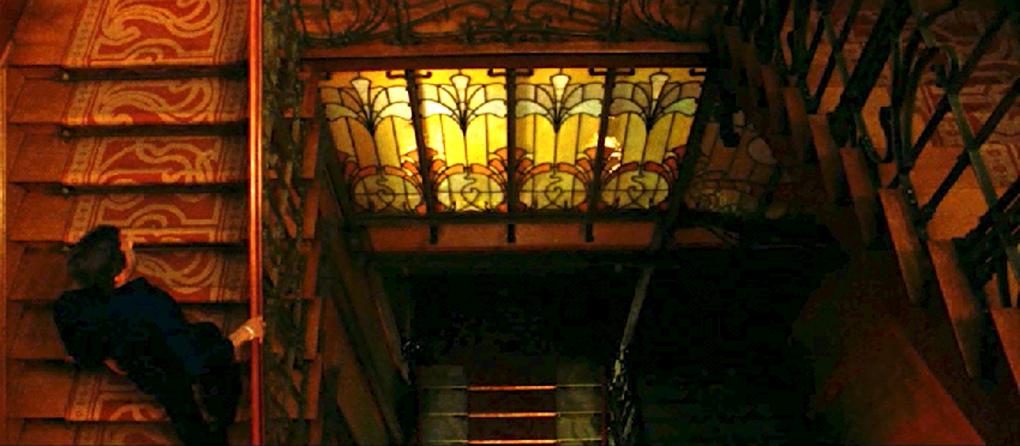


As the narrative progresses we see more features of the building, for instance some floral Art Nouveau stained glass windows by the elevator shaft, as well as other sections of the mural (figure 24). Further shots reveal an Art Nouveau door knob and a decorative stairway balustrade (see figures 25 and 26). In a scene taking place in another person’s apartment, we find a man in a bedroom adorned with Art Nouveau wallpaper and panels depicting naked women (see figure 27). Finally, in yet another resident’s flat, there is a stained glass window portraying a peacock, a veritable symbol of Art Nouveau (see figure 28). As the drama progresses, yet other Art Nouveau elements of the décor become visible: a decorative wall panel, a skylight, more stained glass windows, and a metal fireplace (see figures 29, 30, 31, 32). In line with Art Nouveau’s unconventional erotic vision, many scenes of the film involve sado-masochistic sexuality (for instance, a knife nearly eviscerating a woman’s nipple) (see figure 33).


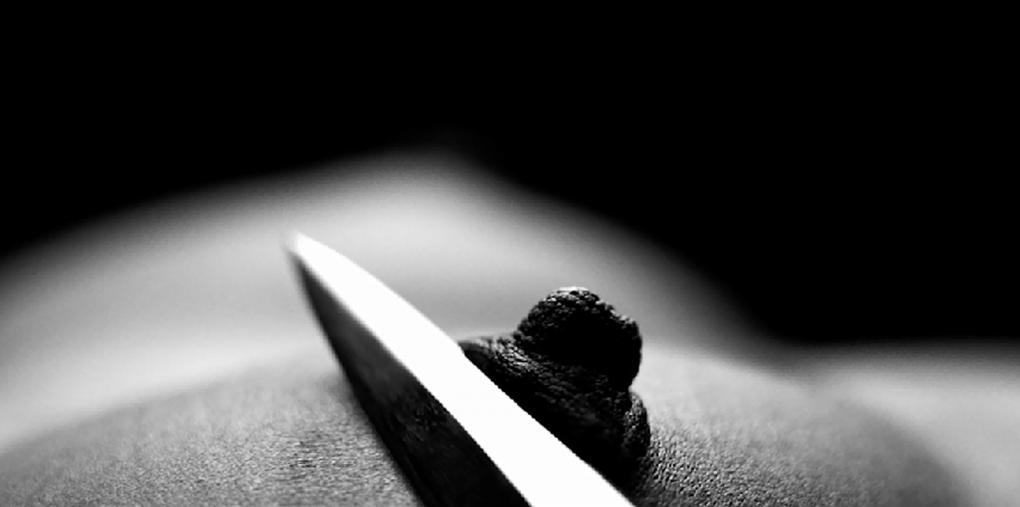
But more pertinent, is the fact that several episodes envision an unsettling force trapped behind a barrier of some kind. In one sequence, a man drills through a ceiling (painted with Art Nouveau maidens) to discover some mysterious being therein (see figure 34); and, in another, a man reaches inside his body to extract some demon (see figure 35). In a third, a man hacks through a tiled surface to reach something (see figure 36); and, in a fourth, a creature trapped behind a wall tries to break through (see figure 37).
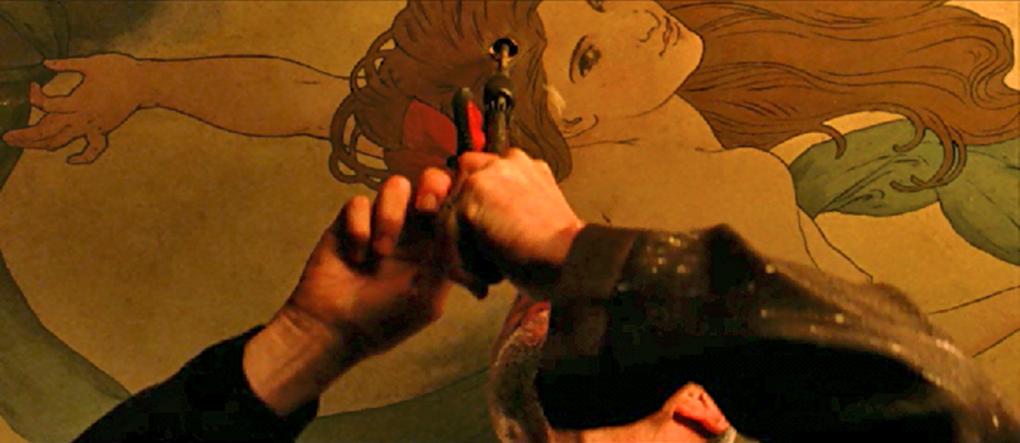

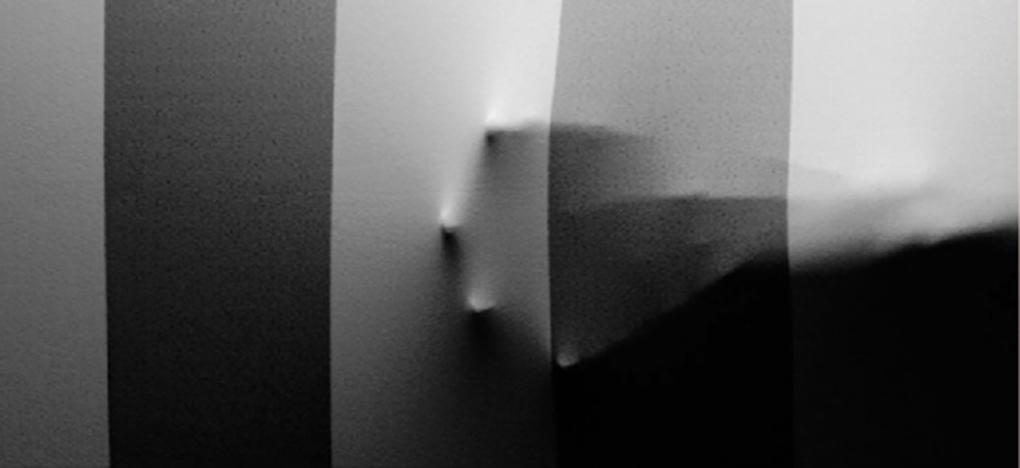
Hence, the film bears comparison to Deep Red with its drawings and corpses concealed behind walls. In both films, an Art Nouveau setting covers over unknown but pernicious forces – ones that are dangerous but demand being exposed. Thus, in the production design of all three horror films, the recourse to Art Nouveau implies that, while that movement is dead and buried – it is really modernism’s un-Dead – a style ready to be exhumed and reanimated at any moment that it is needed to fill a phantasmagoric void in the contemporary Imaginary.
Thus, while the cinema continually finds newer and more imposing ways to create scenes of horror (including CGI and digital technology), it also looks back to the past for the means to instill fear and dread. In the case of the films discussed, this has involved exploring the unsettling sense of Art Nouveau that obtained for some in the early twentieth century, and utilizing its artifacts to create tableaus of terror.
Sections of this article are taken from Lucy Fischer’s book Cinema by Design: Art Nouveau, Modernism and Film History (Columbia University Press, 2017).
BY: LUCY FISCHER / DISTINGUISHED PROFESSOR / FILM AND MEDIA STUDIES AND ENGLISH / UNIVERSITY OF PITTSBURGH
Notes
1. For mentions of Art Nouveau in the critical literature, see Vacche (2008); Galt (2011); Bukatman(2012); Higashi (1994); Gunning (2005: 106-129); and Elsaesser (2000).
2. Carroll Beckwith, “The Workshop of Ugliness,” New York Times, October 4, 1915.
3. “Art Events Here and There,” New York Times, November 20, 1904, http://query.nytimes.com; my emphasis.
4. “A New Vision in Design Has Gripped Germany,” New York Times, July 17, 1927, http://query.nytimes.com; my emphasis.
5. Thomas J. Holmes, “Bookbinding,” New York Times, January 26, 1907, http://query.nytimes.com; my emphasis.
6. Of course, for Benjamin, that term referred to the consumer item under capitalism transformed into an illusionistic, quasi-magical object, divorced from use value and signs of labor. http://www.mediaarthistory.org/refresh/Programmatic%20key%20texts/pdfs/Gunning.pdf
7. Théâtre Grand Guignol, http://exposition-universelle-paris-1900.com/THEATRE_DU_GRAND_GUIGNOL
8. There is a sequel entitled Dr. Phibes Rises Again (1972), but it is not as interesting since most of the film is set in the Egyptian desert (rather than early 20th Century Europe). Its design style is also more influenced by Art Deco than Art Nouveau (though touches of the original film’s mise-en-scène remain).
9. “Art Events Here and There,” 6.
10. https://www.yumpu.com/en/document/view/4478610/teachers-notes-on-art-nouveau-sainsbury-centre-for-visual-arts/7.
11. “Thrill peddler’s GrandGuignol.com/What is Grand Guignol?” GrandGuignol.com, accessed September 29, 2014, http://www.grandguignol.com/tri_2.htm; Gunning, “The Horror of Opacity,” 57.
12. L. Andrew Cooper, Dario Argento, Contemporary Film Directors (Urbana: University of Illinois Press, 2012), “Giallo is an Italian 20th-century genre of literature and film, which in Italian indicates crime fiction and mystery. In English, it refers to a genre similar to the French fantastique genre and includes elements of horror fiction and eroticism. The word ‘giallo’ is Italian for ‘yellow’ and comes from a series of cheap paperback mystery novels with trademark yellow covers.” “Giallo,” Wikipedia, last modified September 25, 2015, http://en.wikipedia.org/wiki/Giallo.
13. “The European Belle Époque,” Belle Époque, last modified September 19, 2014, http://www.la-belle-epoque.de/italien/torindxe.htm.
14. “Villa Scott,” Wikipedia (Italian version), last modified April 28, 2014, http://it.wikipedia.org/wiki/Villa_Scott.
15. Cooper, Contemporary Film Directors, 53.
Bibliography
“A New Vision in Design Has Gripped Germany”. New York Times. (July 17th, 1927).
“Art Events Here and There". New York Times. (November 20th, 1904).
Bade, Patrick (2011). Mucha. New York, Parkstone Press.
Beckwith, Carroll. “The Workshop of Ugliness”. New York Times. (October 4th, 1915).
Bukatman, Scott (2012). The Poetics of Slumberland: Animated Spirits and the Animating Spirit. Berkeley, University of California Press.
Cooper, Andrew L. (2012), Dario Argento. Urbana, University of Illinois Press.
Elsaesser, Thomas (2000). Weimar Cinema and After: Germany’s Historical Imaginary. London, Routledge.
“The European Belle Époque”. Belle Époque. http://www.la-belle-epoque.de/italien/torindxe.
Hand, Richard J., and Wilson, Michael (2000). “What is Grand Guignol?” In: Theatre Research International. Cambridge, Cambridge University Press.
Higashi, Sumiko (1994). Cecil DeMille and American Culture: The Silent Era. Berkeley, University of California Press, 1994.
Holmes, Thomas J. “Bookbinding”. New York Times. (January 26th, 1907).
Galt, Rosalind (2011). Pretty: Film and the Decorative Image. New York, Columbia University Press.
"Giallo". Wikipedia. http://en.wikipedia.org/wiki/Giallo.
Gordon, Mel (1988). The Grand Guignol: Theatre of Fear and Terror. New York, Amok Press.
Gunning, Tom (2004). "Illusions Past and Future: The Phantasmagoria and its Specters". In: Media Art History. University of Chicago Press.
Gunning, Tom (2005). “Light, Motion, Cinema!: The Heritage of Loïe Fuller and Germaine Dulac." Framework.
Gunning, Tom (1994). “The Horror of Opacity". In: Bratton, Jim Cook, and Gledhill, Christine (ed): Melodrama: Stage, Picture, Screen. Bloomington, Indiana University Press.
Fischer, Lucy (2017). Cinema by Design: Art Nouveau, Modernism and Film History. New York, Columbia University Press.
"LATHES Are Used to Cut Me." Yumpu.com. https://www.yumpu.com/en/document/view/4478610/teachers-notes-on-art-nouveau-sainsbury-centre-for-visual-arts/7.
Lombard, Laura (2009). Realism to Art Nouveau. New York, Sterling.
Loos, Adolf (1998). Ornament and Crime: Selected Essays, trans. Michael Mitchell. Riverside, Ariadne Press.
"THEATRE DU GRAND GUIGNOL." Exposition Universelle De Paris 1900. http://exposition-universelle-paris-1900.com/THEATRE_DU_GRAND_GUIGNOL.
Vacche, Angela Dalle (2008). Diva: Defiance and Passion in Early Italian Cinema. Austin: University of Texas Press.
Vajda, György M. (1980). “Some Aspects of Art Nouveau in Arts and Letters.” In: Journal of Aesthetic Education.
“Villa Scott”. Wikipedia. http://it.wikipedia.org/wiki/Villa_Scott.
Watson, Gray F. “Edvard Munch”. In: Encyclopedia Britannica Online. http://www.britannica.com/EBchecked/topic/397389/Edvard-Munch/5076/Paintings-of-love-and-death.
Suggested citation
Fischer, Lucy (2017): Art Nouveau, Production Design, and the Contemporary Horror Film. Kosmorama #268 (www.kosmorama.org).
